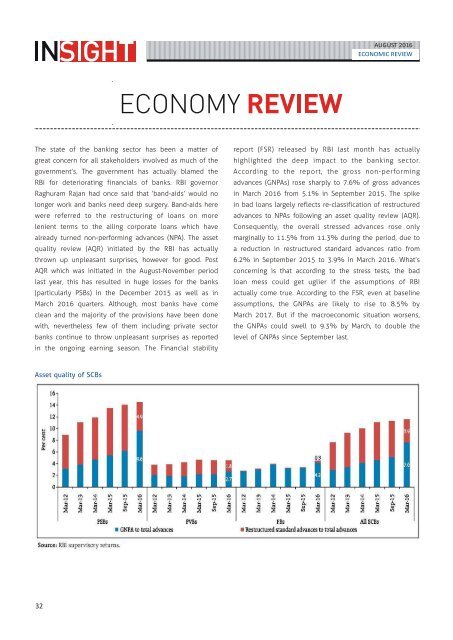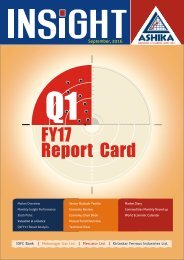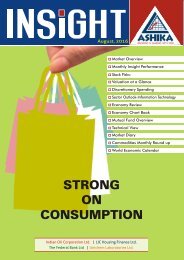You also want an ePaper? Increase the reach of your titles
YUMPU automatically turns print PDFs into web optimized ePapers that Google loves.
AUGUST <strong>2016</strong><br />
ECONOMIC REVIEW<br />
The state of the banking sector has been a matter of<br />
great concern for all stakeholders involved as much of the<br />
government’s. The government has actually blamed the<br />
RBI for deteriorating financials of banks. RBI governor<br />
Raghuram Rajan had once said that ‘band-aids’ would no<br />
longer work and banks need deep surgery. Band-aids here<br />
were referred to the restructuring of loans on more<br />
lenient terms to the ailing corporate loans which have<br />
already turned non-performing advances (NPA). The asset<br />
quality review (AQR) initiated by the RBI has actually<br />
thrown up unpleasant surprises, however for good. Post<br />
AQR which was initiated in the <strong>August</strong>-November period<br />
last year, this has resulted in huge losses for the banks<br />
(particularly PSBs) in the December 2015 as well as in<br />
March <strong>2016</strong> quarters. Although, most banks have come<br />
clean and the majority of the provisions have been done<br />
with, nevertheless few of them including private sector<br />
banks continue to throw unpleasant surprises as reported<br />
in the ongoing earning season. The Financial stability<br />
report (FSR) released by RBI last month has actually<br />
highlighted the deep impact to the banking sector.<br />
According to the report, the gross non-performing<br />
advances (GNPAs) rose sharply to 7.6% of gross advances<br />
in March <strong>2016</strong> from 5.1% in September 2015. The spike<br />
in bad loans largely reflects re-classification of restructured<br />
advances to NPAs following an asset quality review (AQR).<br />
Consequently, the overall stressed advances rose only<br />
marginally to 11.5% from 11.3% during the period, due to<br />
a reduction in restructured standard advances ratio from<br />
6.2% in September 2015 to 3.9% in March <strong>2016</strong>. What’s<br />
concerning is that according to the stress tests, the bad<br />
loan mess could get uglier if the assumptions of RBI<br />
actually come true. According to the FSR, even at baseline<br />
assumptions, the GNPAs are likely to rise to 8.5% by<br />
March 2017. But if the macroeconomic situation worsens,<br />
the GNPAs could swell to 9.3% by March, to double the<br />
level of GNPAs since September last.<br />
Asset quality of SCBs<br />
32






